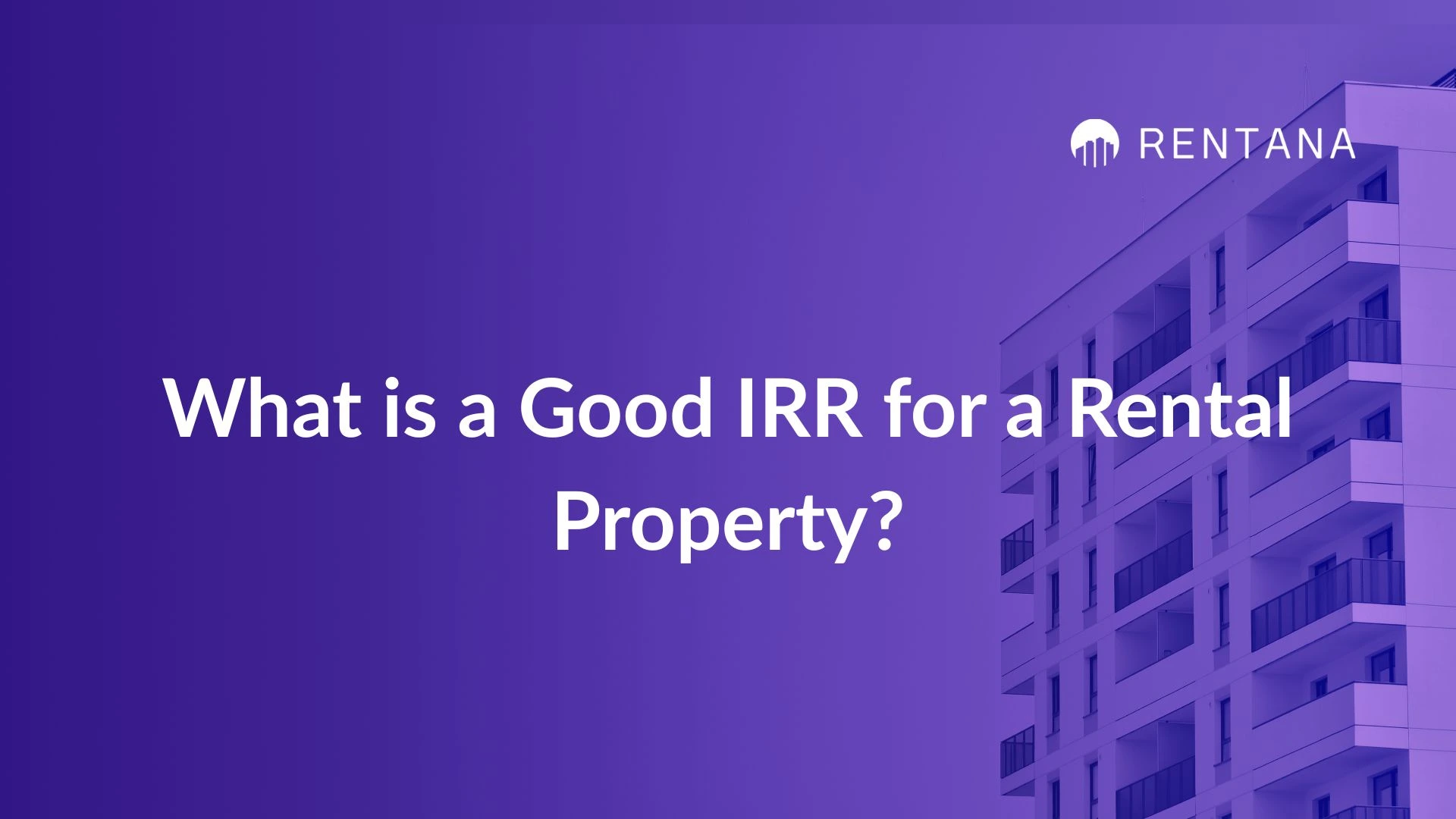




How do you know If a rental property is really a good investment?
Real estate investors are always looking for ways to measure how much money their properties will actually make over time.
One of the most important metrics they use is something called IRR, or Internal Rate of Return.
It might sound complicated, but it’s really just a way to answer a simple question: Is this property worth my time and money compared to other opportunities?
IRR is like a score that tells you how much profit your investment could bring in each year, after accounting for all the money going in and out over time.
A good way to think about it is like a savings account interest rate.
If your duplex shows an IRR of 12%, that means it’s working like a savings account that gives you 12% interest every year. The difference is that with property, the “interest” comes from rent payments, tax benefits, and eventually selling the property for a profit.
Recommended: How To Calculate the Value of a Multifamily Property Easily

The math behind IRR for rental property involves finding the “discount rate” that makes the value of your future cash flows equal the money you invested at the start.
Most investors don’t calculate it by hand.
They use software or spreadsheets. What matters is that IRR shows the real performance of a rental property over time.
For example, imagine you buy a small four-unit property for $200,000. Every year, after paying expenses, you take home about $15,000 in net rental income.
Ten years later, you sell the property for $280,000. IRR takes all of those yearly $15,000 payments plus the profit from the sale, and shows you the average annual return. In this case, your IRR might come out to around 11–12%, giving you a clear number to compare against other opportunities.
It’s easy to confuse IRR with other numbers investors use. ROI, or Return on Investment, usually looks at the total return you make as a percentage of your original investment, but it doesn’t factor in how long it takes.
Cash-on-cash return focuses on how much cash you earn each year compared to the cash you put in upfront, but it doesn’t consider what happens when you eventually sell. IRR pulls the whole picture together. It looks at both the yearly cash flow and the final sale, giving you a clearer idea of whether your rental is a solid long-term performer.
Read Also: Top 9 Real Estate Market Analysis Tools
When it comes to rental property investing, everyone wants to know: What’s a good IRR for rental property? The answer isn’t the same for everyone, but there are some common benchmarks and expectations to help guide your thinking.
In real estate, a good IRR for rental property often falls somewhere between 12% and 18%. That range is generally considered attractive because it suggests the property is producing steady income and has potential for appreciation.
Anything below 10% might not excite most investors unless it’s a very low-risk deal in a stable market. On the flip side, an IRR above 20% usually means higher risk, like a property needing major renovations or being in an unpredictable market.
A good IRR for rental property isn’t one-size-fits-all. It depends on the type of property, its location, and the investor’s strategy. For example, a luxury apartment building in a downtown core may have a lower IRR because it’s a safer bet with long-term stability.
Meanwhile, a small property in a fast-growing suburb might offer a higher IRR because there’s more room for rent growth and appreciation, but also more uncertainty. Investors chasing quick flips often look for higher IRRs, while buy-and-hold investors may be happy with steady but slightly lower returns.
In short, “good” is relative. The key is to match your IRR goals with your risk tolerance and your overall investment strategy.
Related: How To Do A Rental Market Analysis Like a Pro (With AI Tools)

Not every rental property delivers the same returns. Even two buildings on the same street can have very different IRRs depending on how they’re managed and where they are in their lifecycle. Here are five major factors that can make or break your Internal Rate of Return.
The biggest driver of IRR is often rental income. If rents are rising steadily and your units stay full, your returns climb. For example, a 20-unit apartment complex where rents increase by just $50 per month per unit adds $12,000 in annual revenue. On the other hand, if occupancy drops and half your units sit empty for months, your IRR takes a hit even if rental rates are strong on paper.
Expenses are the silent killer of returns. Everything from maintenance and utilities to property management fees cuts into your bottom line. Imagine two investors with identical fourplexes: one self-manages and keeps repairs efficient, while the other pays high management fees and ignores small issues that turn into big ones. The first landlord will almost always see a higher IRR because more cash flow stays in their pocket.
Local market conditions play a huge role. Strong job growth and population growth often lead to higher demand for rentals, which pushes occupancy and rents upward. For instance, a property in Austin, Texas during a population boom might show IRRs of 15–18%. Meanwhile, a similar building in a stagnant market might only deliver 8–10%. Timing matters too. Buying when interest rates are low or when the market is undervalued can improve long-term returns.
How you finance a property directly affects your IRR. A landlord with a fixed 4% mortgage will likely enjoy stronger returns compared to someone paying 7% interest for the same property. Creative financing structures, like interest-only loans or partnerships, can also boost short-term IRRs. But they may come with higher risks when rates rise or loans reset.
IRR always takes into account the money you eventually make when selling the property. Holding for five years versus ten years can change the number dramatically.
For example, selling a property after five years in a hot market at a high price might yield a 16% IRR, while holding it for ten years with slower growth may average closer to 12%. Investors who plan their exit carefully, by choosing the right moment to sell or by adding value before selling, often see the best results.
Together, these factors show why IRR isn’t just about the property itself but about the bigger picture: how you buy, manage, finance, and eventually sell.
Related: 7 Best Asset Management Reporting Software for Multifamily

Technology has changed the way investors look at returns. Instead of waiting until the end of the year to see how a property performed, data-driven platforms now give real-time insights that help project future results.
This makes it much easier to understand whether your rental is moving toward a strong IRR or slipping behind.
The best IRR tool makes this process simple. It pulls together rent collections, occupancy levels, expenses, and market data into clear dashboards. By seeing the whole picture in one place, owners and managers can quickly spot trends, adjust strategies, and keep their returns on track.
This is why Rentana stands out. Rentana uses AI-powered revenue intelligence to show not just what is happening, but why. Rentana's predictive analytics forecast occupancy changes, and even recommends pricing adjustments based on trends.
Transparent reporting also gives investors clear, detailed explanations behind every recommendation, so they can trust the numbers and make faster, smarter decisions.
For a landlord managing a handful of units or an institution overseeing thousands, Rentana provides the tools to easily IRR performance. It takes the guesswork out of reporting and turns data into a roadmap for long-term success.
At the end of the day, a good IRR for rental property depends on what you want to achieve as an investor.
Some landlords may be happy with steady cash flow and a 10% IRR because it provides stability and pays the bills. Others may aim for 15% or higher, willing to take on more risk in exchange for bigger returns. Institutional investors may even accept slightly lower IRRs if it means consistency and long-term growth across a large portfolio.
The important thing is to match your IRR goals with your overall strategy.
If your plan is to buy and hold for the long run, focus on sustainable rent growth and cost control. If your strategy is value-add or flipping, aim for higher IRRs by timing your improvements and sale carefully.
Tools like Rentana can make this process easier by giving you the clarity to see how your properties are really performing. With accurate data and predictive insights, you can make decisions that align not only with today’s numbers but also with your vision for tomorrow.
Don’t Miss: 9 Best AI Tools for Commercial Real Estate
Internal Rate of Return (IRR) measures the profitability of potential real estate investments. It's a comprehensive metric expressed as a percentage, which calculates the annual rate of growth an investment is expected to generate. Unlike simple cash flow calculations, IRR takes into account the time value of money, providing investors with a nuanced understanding of an investment's potential profitability over its lifespan.
While IRR and ROI (Return on Investment) both measure investment performance, they do so differently. ROI is simpler, calculating the overall return of an investment as a percentage of the initial cost. In contrast, IRR provides a more detailed analysis by accounting for the timing and magnitude of cash flows throughout the investment period, effectively measuring the annual growth rate.
Determining a good IRR varies significantly across different markets and types of investments. Generally, a good IRR for real estate investments ranges from 15% to 20%, which is considered strong and reflects a solid return on investment considering the risks involved. However, this benchmark may fluctuate based on economic conditions, location, and the investor's financial goals.
IRR is crucial in real estate investing because it provides a comprehensive view of an investment's financial performance, considering both the timing and the amount of cash flows. This enables investors to compare the profitability of different investment opportunities equally, aiding in making informed, data-driven decisions.
Calculating the IRR for a property involves identifying all cash flows associated with the investment, including the initial purchase cost and all subsequent income and expenses over the investment's life. The IRR is the rate that makes the net present value (NPV) of these cash flows equal to zero. While manually computing IRR can be complex due to its iterative nature, financial calculators and software can simplify the process.
Several factors can impact what is considered a good IRR in real estate, including:
Risk Profile: Higher-risk investments usually require a higher IRR to be considered attractive.